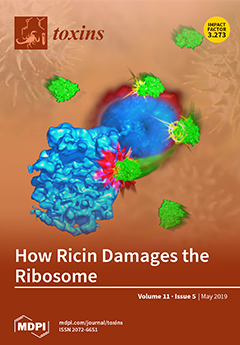A major virulence factor involved in
Bacillus cereus food poisoning is the three-component enterotoxin hemolysin BL. It consists of the binding component B and the two lytic components L
1 and L
2. Studying its mode of action has been challenging, as
[...] Read more.
A major virulence factor involved in
Bacillus cereus food poisoning is the three-component enterotoxin hemolysin BL. It consists of the binding component B and the two lytic components L
1 and L
2. Studying its mode of action has been challenging, as natural culture supernatants additionally contain Nhe, the second three-component enterotoxin, and purification of recombinant (r) Hbl components has been difficult. In this study, we report on pore-forming, cytotoxic, cell binding and hemolytic activity of recently generated rHbl components expressed in
E. coli. It is known that all three Hbl components are necessary for cytotoxicity and pore formation. Here we show that an excess of rHbl B enhances, while an excess of rHbl L
1 hinders, the velocity of pore formation. Most rapid pore formation was observed with ratios L
2:L
1:B = 1:1:10 and 10:1:10. It was further verified that Hbl activity is due to sequential binding of the components B - L
1 - L
2. Accordingly, all bioassays proved that binding of Hbl B to the cell surface is the crucial step for pore formation and cytotoxic activity. Binding of Hbl B took place within minutes, while apposition of the following L
1 and L
2 occurred immediately. Further on, applying toxin components simultaneously, it seemed that Hbl L
1 enhanced binding of B to the target cell surface. Overall, these data contribute significantly to the elucidation of the mode of action of Hbl, and suggest that its mechanism of pore formation differs substantially from that of Nhe, although both enterotoxin complexes are sequentially highly related.
Full article






